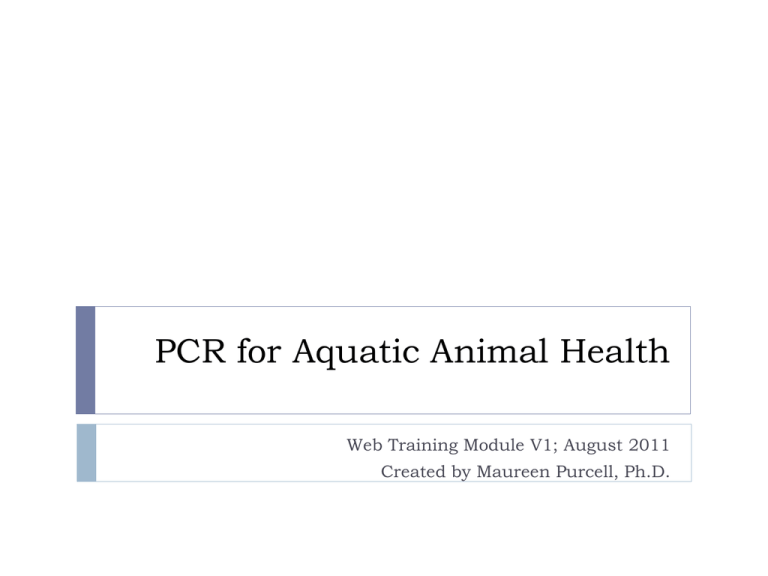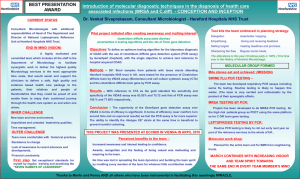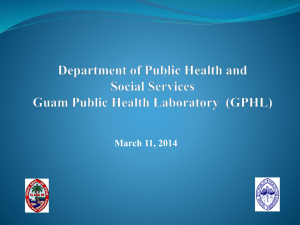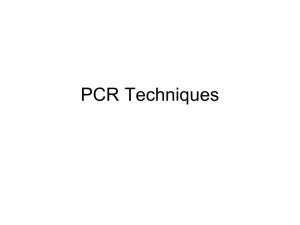Quantitative “Real Time” PCR
advertisement

PCR for Aquatic Animal Health Web Training Module V1; August 2011 Created by Maureen Purcell, Ph.D. Goal To provide an overview of PCR-based diagnostic assays with an emphasis on basic theory • Want to learn more? • Click on the reference links located at the bottom of certain slides Content Overview PCR basics Commonly used PCR assays Advantages and disadvantages of PCR Good laboratory practices Analytical validation Sampling and template preparation Primers Standards, controls and normalization Quantitative PCR – in depth Purcell, M.K. et al. (2011) Quantitative polymerase chain reaction (PCR) for detection of aquatic animal pathogens in a diagnostic laboratory setting. J. Aq. An. Health. 23:148-161. http://www.tandfonline.com/doi/abs/10.1080/08997659.2011.620217 PCR Basics Polymerase chain reaction (PCR) is a method to amplify a target sequence from background nucleic acid PCR uses synthetic oligonucleotide primers that flank target sequence Forward Primer T DNA synthesis is catalyzed in vitro by a heat stable DNA polymerase Target Sequence 5’ Forward Primer 3’ Reverse Primer Reverse Primer Taq Polymerase Lodish H, A. et al.. (2000) Polymerase chain reaction, an alternative to cloning. In Molecular Cell Biology. 4th edition. W.H. Freeman, NY. Section 7.7. http://www.ncbi.nlm.nih.gov/books/NBK21541/ PCR Basics PCR basic steps Denature DNA (94°C) Anneal primer (~50 = 65°C) 5’ 3’ 3’ 5’ 5’ 3’ Forward Primer Reverse Primer 3’ T Extension (72°C) 5’ Forward Primer Reverse Primer http://www.idtdna.com/pages/docs/educational-resources/the-polymerase-chain-reaction.pdf PCR Basics Stages of PCR Plateau Phase Linear Phase Log Target Exponential (Geometric) Phase Stochastic/ ‘lag’ phase Cycle Number http://www6.appliedbiosystems.com/support/tutorials/pdf/rtpcr_vs_tradpcr.pdf PCR Basics Theoretically the target sequence is doubled every PCR cycle This doubling each cycle equates to 100% PCR efficiency or an efficiency (E) of 2 Theoretical Log Target Cycle Number PCR Basics In practice, PCR efficiency will vary depending on a range of factors Theoretical Efficiency (E) = 2 Log Target DNA Actual Efficiency (E) < 2 Cycle Number Commonly Used PCR Assays Conventional PCR utilizes two primers and products are detected by gel electrophoresis “cPCR” Agarose gel electrophoresis following PCR Log Target Cycle Number http://www.idtdna.com/pages/docs/educational-resources/gel-electrophoresis.pdf Commonly Used PCR Assays A reverse-transcriptase step can be added to the PCR when the starting template is RNA “RT-PCR” The RT reaction can be primed by a: target specific primer (i.e. primer targeting VHSV nucleocapsid (N) gene) oligo dT primer (a primer consisting of a run of T’s that targets the mRNA poly A tail) random primers (a mix of 6 base primers consisting of random nucleotides) All messenger RNAs (mRNA) have a poly A tail RNA AAAAAAAAAAAA TTTTTT oligo dT primer http://www.invitrogen.com/site/us/en/home/Products-and-Services/Applications/Nucleic-Acid-Amplification-andExpression-Profiling/Reverse-Transcription-and-cDNA-Synthesis/RNA-Priming-Strategies.html Commonly Used PCR Assays A reverse-transcriptase step can be added to the PCR when the starting template is RNA “RT-PCR” RNA is copied into complementary DNA (cDNA) by the reverse transcriptase enzyme RNA cDNA AAAAAAAAAAAA TTTTTT http://www.invitrogen.com/site/us/en/home/Products-and-Services/Applications/Nucleic-Acid-Amplification-andExpression-Profiling/Reverse-Transcription-and-cDNA-Synthesis/RNA-Priming-Strategies.html Commonly Used PCR Assays Some vendors sell “one-step RT-PCR” master mixes This is a misnomer and should be called onetube RT-PCR RT-PCR always involves two steps 1. Reverse-transcriptase 2. PCR These steps can be performed in the same reaction tube (aka one-step) or in separate reaction tubes Commonly Used PCR Assays Nested PCR (“nPCR”) involves two rounds of PCR utilizing outer and inner primer sets to improve sensitivity (because two rounds of PCR are performed) and specificity (since all four primers must match the target sequence) Target DNA Region (i.e. Msa gene from R. salmoninarum) Outer Forward Primer Outer Reverse Primer 1st Round PCR Product Inner Forward Primer Inner Reverse Primer 2nd Round PCR Product http://www.oie.int/fileadmin/Home/eng/Health_standards/tahm/1.1.05._VALID_PCR.pdf Commonly Used PCR Assays Real-time PCR detects a fluorescent signal that is increased each time a template is copied; the fluorescent signal is monitored each cycle or in ‘real-time’ ∆ Fluorescence Threshold CT CT Cycle Number CT = The cycle that a PCR reaction crosses the designated threshold Also called cycle quantification (CQ) or crossing point (CP) http://www6.appliedbiosystems.com/support/tutorials/pdf/rtpcr_vs_tradpcr.pdf Commonly Used PCR Assays Quantitative PCR relies on the principal that the quantity of target at the start of the reaction is proportional to amount of product produced during the exponential phase ∆ Fluorescence Greater starting target Less starting target CT < CT Commonly Used PCR Assays Real-time PCR is often used synonymously with quantitative PCR Real-time PCR involves monitoring the fluorescent signal produced during every cycle Real-time PCR results can be interpreted as plus or minus (detectable / not detectable) amplification Real-time PCR results can be used to estimate starting quantity of the target sequence in a sample = quantitative PCR Commonly Used PCR Assays Suggested terminology and acronyms for each assay type Assay type Acronym Nucleic acid target Result cPCR DNA Plus / Minus RT-cPCR RNA Plus / Minus nPCR DNA Plus / Minus RT-nPCR RNA Plus / Minus Detection by gel-based electrophoresis Conventional PCR Reverse transcriptase conventional PCR Nested PCR Reverse transcriptase nested PCR Detection by fluorescent monitoring in a real-time PCR instrument Quantitative PCR Reverse transcriptase quantitative PCR Real-time PCR Reverse transcriptase real-time PCR qPCR DNA CT / Pathogen copy RT-qPCR RNA CT / Pathogen copy rPCR DNA Plus / Minus RT-rPCR RNA Plus / Minus Advantages and Disadvantages of PCR Detection of pathogens with PCR-based tests have a number of general advantages Assays are typically highly sensitive Assays are typically highly specific Assays can be run in a high through-put manner Purcell, M.K. et al. (2011) Quantitative polymerase chain reaction (PCR) for detection of aquatic animal pathogens in a diagnostic laboratory setting. J. Aq. An. Health. 23:148-161. http://www.tandfonline.com/doi/abs/10.1080/08997659.2011.620217 Advantages and Disadvantages of PCR Detection of pathogens with PCR-based tests have a number of general disadvantages Failure to detect pathogen template due to genetic variation at primer sites leading to false-negative results Inhibitors in samples leading to false-negative results High risk of contamination leading to false-positive results No indication of pathogen viability Confirms presence of nucleic acid but not infection Only a small proportion of the tissue is examined per reaction Purcell, M.K. et al. (2011) Quantitative polymerase chain reaction (PCR) for detection of aquatic animal pathogens in a diagnostic laboratory setting. J. Aq. An. Health. 23:148-161. http://www.tandfonline.com/doi/abs/10.1080/08997659.2011.620217 Advantages and Disadvantages of PCR Nested PCR for pathogen detection 104 103 102 101 Advantages Bacterial Quantity Two rounds of PCR improves sensitivity Two sets of primers improves specificity Conventional PCR - - Disadvantages Prone to contamination from amplified PCR products Time consuming to perform two PCR rounds Nested PCR + + Purcell, M.K. et al. (2011) Quantitative polymerase chain reaction (PCR) for detection of aquatic animal pathogens in a diagnostic laboratory setting. J. Aq. An. Health. 23:148-161. http://www.tandfonline.com/doi/abs/10.1080/08997659.2011.620217 Advantages and Disadvantages of PCR Quantitative PCR has several advantages over conventional and nested PCR assays Obtain quantitative estimate of target Semi-automated Rapid results No handling of amplified DNA which limits potential laboratory contamination Some assays use an internal probe that provides added specificity Good assay parameters Large dynamic range Low inter-assay variation Highly reliable Purcell, M.K. et al. (2011) Quantitative polymerase chain reaction (PCR) for detection of aquatic animal pathogens in a diagnostic laboratory setting. J. Aq. An. Health. 23:148-161. http://www.tandfonline.com/doi/abs/10.1080/08997659.2011.620217 Good Laboratory Practices All PCR-based assays are prone to contamination Need dedicated spaces for different activities: Clean Room: storage and preparation of PCR reagents Sample Preparation: all samples and controls processed High Risk Templates: plasmid DNA or synthetic controls at high concentrations Nested PCR: handling of first round PCR products Dirty Room: PCR amplification and handling of amplified products •Work flow in unidirectional moving from clean to dirty •No exchange of equipment, materials or lab jackets Quality Assurance / Quality Control for the Fish and Wildlife Fish Health Laboratories: http://www.fws.gov/aah/PDF/QI-FWS%20AAHP%20QA%20Program.pdf Analytical Validation Validation encompasses assay development, assay optimization, analytical performance at the bench-top scale, and diagnostic performance to establish the fitness of a new diagnostic assay for its intended purpose Important to evaluate properties of specificity, sensitivity and repeatability for all diagnostic tests http://www.oie.int/fileadmin/Home/eng/Health_standards/aahm/2010/1.1.2_VALID.pdf Analytical Validation Definition of important terms Term Definition Fitness of purpose The intended purpose of the assay Analytical sensitivity (ASe) The minimum number of copies reliably detected by the assay Analytical specificity (ASp) The degree to which the assay does not detect (amplify) other pathogens Limit of detection (LOD) Another term to describe analytical sensitivity Repeatability Agreement between sample replicates, both within an assay run and between independent assay runs, when tested by the same laboratory Reproducibility Agreement among test results when the same samples is tested by different laboratories Ruggedness Reproducibility of an assay using different reagent brands or batches and different equipment http://www.oie.int/fileadmin/Home/eng/Health_standards/aahm/2010/1.1.2_VALID.pdf Analytical Validation Analytical sensitivity (ASe) / limit of detection (LOD) Theoretically one copy of the target must be present in the reaction for PCR to occur but this copy number will not be reliably detected Samples at or below the LOD typically have poor repeatability Extending the assay cycle numbers well beyond the LOD may produce spurious results http://www.oie.int/fileadmin/Home/eng/Health_standards/aahm/2010/1.1.2_VALID.pdf Sampling and Template Preparation Sample acquisition represents the first source of experimental variability Laboratories need clear acceptance / rejection criteria for a sample Sample integrity must be maintained between collection, transport and receipt of sample Nucleic acid degrading solution (e.g. sodium hypochlorite or commercial product) should be used to clean non-disposable sampling tools and work spaces between samples Alcohol and/or flaming tools is not sufficient to prevent cross-contamination of samples Quality Assurance / Quality Control for the Fish and Wildlife Fish Health Laboratories: http://www.fws.gov/aah/PDF/QI-FWS%20AAHP%20QA%20Program.pdf Sampling and Template Preparation Stabilizing nucleic acids RNA degrades rapidly and should be stabilized immediately Common stabilization methods for RNA Snap-freezing in liquid nitrogen RNA stabilizing solution (e.g. RNAlater®) Long-term storage at -80°C DNA is more stable but can degrade if not properly handled Common stabilization methods for DNA Freezing at -20°C or -80°C 95% ethanol Drying on special filters (e.g. FTA® Cards) Sampling and Template Preparation Important to be familiar with general principles of working with RNA: Avoid RNAses Always wear gloves when handling reagents or equipment that will be used in the RNA extraction and reverse transcription procedures RNAse-free water can be commercially purchased or nanopure water can be treated with diethyl pyrocarbonate (DEPC) http://www.promega.com/~/media/files/resources/product%20guides/rna%20analysis%20notebook/workingwithrna .ashx?la=en Sampling and Template Preparation A variety of commercial kits exist to extract nucleic acids New extraction methodologies need to be evaluated to assess impact on assay sensitivity High throughput methods need careful evaluation to ensure that no crosscontamination occurs among samples Spectrophotometric analysis to obtain DNA concentration is useful for monitoring extraction efficiency http://www.nanodrop.com/Library/T009-NanoDrop%201000-&-NanoDrop%208000-Nucleic-Acid-Purity-Ratios.pdf Primers A variety of commercial companies can synthesize oligonucleotide primers Primers typically arrive lyophilized, are rehydrated with nuclease-free water, and stored at -20°C ‘Dilution’ and ‘Resupension’ online calculators to assist in primer dilution http://www.idtdna.com/analyzer/Applications/DilutionCalc/ http://www.idtdna.com/analyzer/Applications/resuspensioncalc/ Standards, controls and normalization Standard: a sample of a known concentration/copy number used to construct the standard curve Control: various samples that ensure the validity of positive and negative results Normalization: corrects for variation in template quantity and/or template quality Endogenous: target naturally present in sample (e.g. host gene) Exogenous: artificial target that is spiked into the sample *See reference below for in depth discussion Purcell, M.K. et al. (2011) Quantitative polymerase chain reaction (PCR) for detection of aquatic animal pathogens in a diagnostic laboratory setting. J. Aq. An. Health. 23:148-161. http://www.tandfonline.com/doi/abs/10.1080/08997659.2011.620217 Standards, controls and normalization Standard: a sample of a known concentration/copy number used to construct the standard curve Standards are typically used when quantitative results are desired = quantitative PCR Purcell, M.K. et al. (2011) Quantitative polymerase chain reaction (PCR) for detection of aquatic animal pathogens in a diagnostic laboratory setting. J. Aq. An. Health. 23:148-161. http://www.tandfonline.com/doi/abs/10.1080/08997659.2011.620217 Standards, controls and normalization A good standard: Stable Mimics the biological target Can be accurately quantified New batches can be reliably produced Not a high contamination risk for the laboratory Purcell, M.K. et al. (2011) Quantitative polymerase chain reaction (PCR) for detection of aquatic animal pathogens in a diagnostic laboratory setting. J. Aq. An. Health. 23:148-161. http://www.tandfonline.com/doi/abs/10.1080/08997659.2011.620217 Standards, controls and normalization Standards for DNA targets Plasmid DNA containing PCR target Single-stranded oligodeoxynucleotides Quantified pathogen culture e.g. Bacterium quantified by FAT e.g. CFU or PFU quantified pathogen e.g. Purified parasite spores Standards for RNA target Same as above In vitro transcript generated from plasmid (synthesized using T3 or T7 RNA polymerase) Purcell, M.K. et al. (2011) Quantitative polymerase chain reaction (PCR) for detection of aquatic animal pathogens in a diagnostic laboratory setting. J. Aq. An. Health. 23:148-161. http://www.tandfonline.com/doi/abs/10.1080/08997659.2011.620217 Standards, controls and normalization Control: various samples that ensure the validity of positive and negative results Controls Distinguish: true positives and true negatives from false positives and false negatives Purcell, M.K. et al. (2011) Quantitative polymerase chain reaction (PCR) for detection of aquatic animal pathogens in a diagnostic laboratory setting. J. Aq. An. Health. 23:148-161. http://www.tandfonline.com/doi/abs/10.1080/08997659.2011.620217 Standards, controls and normalization Optimal set of controls: Processing positive control Control for false negatives and extraction efficiency Processing negative control Control for false positives (extraction contamination) PCR no template control Control for false positives (PCR contamination) Standards diluted to the detection limit Control for false negatives Internal positive control (IPC) Irrelevant template and primers that are added to the assay Detects assay inhibitors (leading to false negatives) Purcell, M.K. et al. (2011) Quantitative polymerase chain reaction (PCR) for detection of aquatic animal pathogens in a diagnostic laboratory setting. J. Aq. An. Health. 23:148-161. http://www.tandfonline.com/doi/abs/10.1080/08997659.2011.620217 Standards, controls and normalization Normalization: corrects for variation in template quantity and/or template quality Normalization is typically only performed when data are quantitative Purcell, M.K. et al. (2011) Quantitative polymerase chain reaction (PCR) for detection of aquatic animal pathogens in a diagnostic laboratory setting. J. Aq. An. Health. 23:148-161. http://www.tandfonline.com/doi/abs/10.1080/08997659.2011.620217 Standards, controls and normalization External (Exogenous) Normalizing Variables Tissue weight extracted Nucleic acid concentration Internal (Endogenous) Normalizing Variables RNA: endogenous host gene (housekeeping gene) DNA: can be done but not common Purcell, M.K. et al. (2011) Quantitative polymerase chain reaction (PCR) for detection of aquatic animal pathogens in a diagnostic laboratory setting. J. Aq. An. Health. 23:148-161. http://www.tandfonline.com/doi/abs/10.1080/08997659.2011.620217 Standards, controls and normalization Normalizing to tissue weight Advantages Typical ‘Fish Health Units’ e.g. CFU/g tissue gene copies/g tissue Disadvantages Extraction efficiency may vary Does not detect degradation of sample or inhibitors Normalizing to nucleic acid concentration Advantages Independent of extraction efficiency Done correctly, can be fairly reliable Disadvantages Time consuming to quantify samples Accuracy of spectrophotometer Impact of contaminating nucleic acids Does not detect degradation of sample or inhibitors Purcell, M.K. et al. (2011) Quantitative polymerase chain reaction (PCR) for detection of aquatic animal pathogens in a diagnostic laboratory setting. J. Aq. An. Health. 23:148-161. http://www.tandfonline.com/doi/abs/10.1080/08997659.2011.620217 Standards, controls and normalization Normalizing to endogenous host gene Not recommended because expression of the typical endogenous normalizing gene varies considerably Inappropriate in field samples to use as a measure of ‘RNA quantity’ Results should not be used to ‘normalize’ pathogen copy number Amplification of a housekeeping gene can be used to assess RNA quality (i.e. as a ‘control’) Purcell, M.K. et al. (2011) Quantitative polymerase chain reaction (PCR) for detection of aquatic animal pathogens in a diagnostic laboratory setting. J. Aq. An. Health. 23:148-161. http://www.tandfonline.com/doi/abs/10.1080/08997659.2011.620217 Standards, controls and normalization Recommendations for the use of controls, standards and normalization Category Standards Type Standard curve Positive processing sample Negative processing sample No template control for reaction Internal positive control (IPC) Recommendation Always recommended when quantitative results are desired Always recommended to include a minimum of one positive reference sample per assay run Always recommended to verify nucleic acid extraction effectiveness Always recommended to detect contamination during extraction process Always recommended on every assay run to detect contamination in reagents Good practice for detecting false negative results if IPC does not interfere with assay sensitivity Amplification of endogenous gene Good practice for ensuring nucleic acid integrity and troubleshooting Exogenous normalization variables Good practice to track tissue weight and nucleic acid concentration; normalizing copy number to these variables is dependent on goals Not recommended to normalize copy number to endogenous gene expression in field samples Reference sample Controls Normalization Normalization to endogenous gene Purcell, M.K. et al. (2011) Quantitative polymerase chain reaction (PCR) for detection of aquatic animal pathogens in a diagnostic laboratory setting. J. Aq. An. Health. 23:148-161. http://www.tandfonline.com/doi/abs/10.1080/08997659.2011.620217 Quantitative PCR – in depth Major assay types Fluorogenic 5’ Nuclease Assay Basis of TaqMan® chemistry Uses two primers and an internal hydrolysis probe Most commonly used for fish health diagnostics SYBR ® green dye chemistry Increased fluorescence when bound to dsDNA Slightly lower specificity Costs less May not be as sensitive as the 5’ nuclease assays http://www.clinical-virology.org/pdfs/PCR_experience.pdf Quantitative PCR – in depth Fluorogenic 5’ Nuclease Assay Step 1: Anneal and Polymerization Forward Primer R Taq Polymerase Step 2: Strand Displacement Probe Q Energy from fluorophore transferred to quencher Reverse Primer R T Q R Step 3: Cleavage Polymerization Complete Q Probe must hybridize specifically for cleavage A probe is cleaved each time a target is copied Quantitative PCR – in depth Dual-labeled internal hydrolysis probes 5’ reporter dye (typically Fam/Vic etc.) 3’ quencher (typically non-fluorescent) Can order from a range of oligo companies Many companies have proprietary modifications for internal hydrolysis probes Minor Grove Binding (MGB) – Applied Biosystems Inc. The MGB linker raises the melting temperature of the internal hydrolysis probe and increases probe specificity http://www3.appliedbiosystems.com/cms/groups/mcb_support/documents/generaldocuments/cms_083 618.pdf Quantitative PCR – in depth Most common to use a commercial real-time PCR master mix Variety of vendors Variety of proprietary formulations Empirically evaluate how different formulations impact assay sensitivity Most master mixes contain: Passive normalizing dye to correct for variation in master mix concentration Hot-start Taq polymerase activation so reactions can be set-up at room temperature System to degrade post-PCR products Uracil-N-Glycosylase (UNG) degrades amplified products that have dUTP Quantitative PCR – in depth Analysis of real-time PCR results are specific to the instrument Most instrument vendors provide training and technical support Quantitative PCR – in depth Standards are needed if quantitative results are desired Standard curve that plots log copy number against cycle threshold (CT) 35 y = -3.3169x + 38.322 30 R2 = 0.9989 25 CT 20 15 10 5 0 0.0 2.0 4.0 6.0 8.0 10.0 Log Copy # Quantity is determined by equation of the line Antilog ((CT-y int)/m) Quantitative PCR – in depth Reliable endpoint of assay should be defined empirically during assay validation 5 plasmid copies 40.0 y = -3.5689x + 38.561 R2 = 0.99 35.0 30.0 25.0 CT 20.0 15.0 10.0 5.0 0.0 0.0 1.0 2.0 3.0 4.0 Log (RS plasmid copies) 5.0 6.0 Analytical sensitivity: the smallest number of genome copies that can be (reliably) detected and distinguished from zero Quantitative PCR – in depth Low initial starting copy numbers impacts the accuracy and precision of quantitative PCR Statistical errors impact quantification when starting copy number is < 1000 Results are not always reproducible beyond the reliable endpoint of the assay Random effects in PCR Acknowledgements Prepared by: Maureen Purcell Western Fisheries Research Center U.S. Geological Survey 6505 NE 65th St, Seattle WA 98034 mpurcell@usgs.gov The use of trade, firm, or corporation names in this publication is for the information and convenience of the reader. Such use does not constitute an official endorsement or approval by the U.S. Department of Interior or U.S. Geological Survey of any product or service to the exclusion of others that may be suitable.








